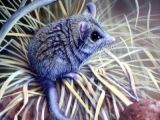Most mammals don't see colors at all - they live in a black-and-white world. Marsupials and primates are among the few mammals who can see colors. Scientists know this because there are distinct cells in the retina responsible for color vision and for black-and-white vision. Color vision is done with the help of "cone" cells, while black-and-white (and grey) vision is done with the help of "rod" cells. Most mammals have only rods.
The cones are of three types. In case of primates (including humans) there are red, green and blue cones, each able to absorb a certain part of the light spectrum. The sensation of color is created by the brain, each sensation of color being a combination of the three fundamental colors. It is interesting to note that we have sensations of certain colors (such as brown) that don't exist in the light spectrum - they are entirely created by the brain and don't exist in "pure" form in nature.
The rods are only of two types - one type sensible to light having a "short" wavelength (such as blue) and another type sensible to light having a "long" wavelength (such as red). Color vision has evolved from black-and-white vision: the rods sensible to "long" wavelengths separated in two types (one type sensible to red, the red cones, and another type sensible to green, the green cones).
Scientists have recently found that marsupials also have three types of cones. As you might guess, the evolution of the marsupial color vision system was completely distinct from the evolution of primate color vision. And there are some very interesting differences.
The three types of cones marsupials have are not red, green, and blue; they are red, blue, and UV. In their case it was the "short" wavelength rod that separated in two cones (the blue and ultraviolet). But what sensations of color do they have? Your guess is as better as anyone's.
Anyway, one can try obtaining some clues about the marsupial's sensations of color by doing behavioral tests. We for instance have the same sensation of color (say "green") for all sorts of different input combinations of wavelengths - we see "green" when green light enters our eyes, but we also see "green" when a combination of blue and yellow light enters our eyes, even no green light is present whatsoever. So, we can express the sensation of color as a function of the wavelengths of the input light.
Scientists could try to do such tests on marsupials - see what combinations of wavelengths lead to the same behavioral result. Eventually the marsupial sensations of color could be understood - although only mathematically.
Dr. Catherine Arrese of the University of Western Australia and her colleagues started to do such behavioral test on the fat-tailed dunnart, using various mixtures of wavelengths, but insofar they have only decided that the marsupials do indeed have color vision, which includes the ability of seeing ultraviolet light. The fat-tailed dunnart (photos) is a furry marsupial, the size of a mouse and which is mostly insectivorous.
As a science-fiction upshot of this discovery one can wonder how would it be if our blue cones would further separate into blue and UV cones, so we would end up with four cones - red, green, blue and UV. That would permit us to have incredibly more sensations of color than we have today - because the possible combinations of four types of cones are much more numerous than those of only three. I would certainly like to have such eyes.
I suggest scientists should try to genetically engineer a monkey by adding to its genome the marsupial genes for color vision (both the genes for primate color vision and for marsupial color vision are known).
Photo credit: Alan Henderson

 14 DAY TRIAL //
14 DAY TRIAL // 
